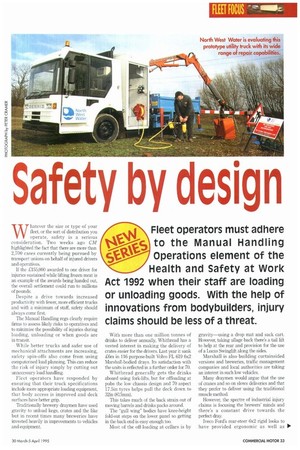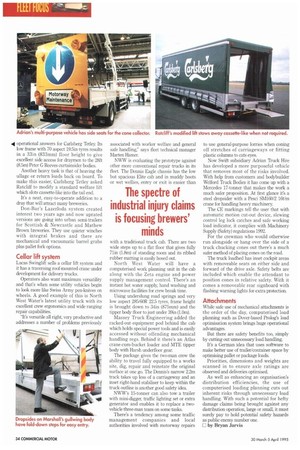Safety by design
Page 35

Page 36

If you've noticed an error in this article please click here to report it so we can fix it.
Whatever the size or type of your fleet, or the sort of distribution you operate, safety is a serious consideration. Two weeks ago CM highlighted the fact that there are more than 2,700 cases currently being pursued by transport unions on behalf of injured drivers and operatives,
If the £155,000 awarded to one driver for injuries sustained while lifting frozen meat is an example of the awards being handed out, the overall settlement could run to millions of pounds.
Despite a drive towards increased productivity with fewer, more efficient trucks and with a minimum of staff, safety should always come first.
The Manual Handling regs clearly require firms to assess likely risks to operatives and to minimise the possibility of injuries during loading, unloading or when goods are in transit.
While better trucks and safer use of mechanical attachments are increasing, safety spin-offs also come from using computerised load planning. This can reduce the risk of injury simply by cutting out unnecessary load handling.
Fleet operators have responded by ensuring that their truck specifications include more appropriate loading equipment, that body access is improved and deck surfaces have better grip.
Traditionally brewery draymen have used gravity to unload kegs, crates and the like but in recent times many breweries have invested heavily in improvements to vehicles and equipment.
With more than one million tonnes of drinks to deliver annually, Whitbread has a vested interest in making the delivery of crates easier for the drivers. Last year it sank £6m in 116 purpose-built Volvo FL 619 6x2 Marshall-bodied drays. Its satisfaction with the units is reflected in a further order for 70,
Whitbread generally gets the drinks aboard using fork-lifts, but for offloading at pubs the low chassis design and 70 aspect 17.5in tyres helps pull the deck down to 32in (815mm).
This takes much of the back strain out of moving barrels and drinks packs around.
The "gull wing" bodies have knee-height fold-out steps on the lower panel so getting in the back end is easy enough too.
Most of the off-loading at cellars is by
gravity—using a drop mat and sack cart. However, taking ullage back there's a tail lift to help at the rear and provision for the use of a Lucas Swinglift along the sides.
Marshall is also building curtainsided versions and breweries, traffic management companies and local authorities are taking an interest in such low vehicles, Many draymen would argue that the use of cranes and so on slows deliveries and that they prefer to deliver using the traditional muscle method.
However, the spectre of industrial injury claims is focusing the brewers' minds and there's a constant drive towards the perfect dray.
lveco Ford's rear.steer 6x2 rigid looks to have provided ergonomic as well as operational answers for Carlsberg Tetley. Its low frame with 70 aspect 19.5in tyres results in a 33in (833mm) floor height to give excellent side access for draymen to the 28ft (8.5m) Peter G Reeves curta insider bodies.
Another heavy task is that of heaving the ullage or return loads back on board. To make this easier, Carlsberg Tetley asked Ratcliff to modify a standard welfare lift which slots cassette-like into the tail end.
It's a neat, easy-to-operate addition to a dray that will attract many breweries.
Don-Bur's Lazerloda system created interest two years ago and now uprated versions are going into urban semi-trailers for Scottish & Newcastle and Mathew Brown breweries. They use quieter winches with integral brakes and there are mechanical and vacuumatic barrel grabs plus pallet fork options.
Cellar lift system
Lucas Swinglift sells a cellar lift system and it has a traversing roof-mounted crane under development for delivery trucks.
Operators also want maximum versatility and that's when some utility vehicles begin to look more like Swiss Army pen-knives on wheels. A good example of this is North West Water's latest utility truck with its excellent crew ergonomics and wide ranging repair capabilities.
"It's versatile all right, very productive and addresses a number of problems previously associated with worker welfare and general safe handling," says fleet technical manager Marten Hamer.
NWW is evaluating the prototype against other more conventional repair trucks in its fleet. The Dennis Eagle chassis has the low but spacious Elite cab and in muddy boots or wet wellies, entry or exit is easier than with a traditional truck cab. There are two wide steps up to a flat floor that gives fully 71in (1.8m) of standing room and its ribbed rubber matting is easily hosed out.
North West Water will have a computerised work planning unit in the cab along with the Zeta engine and power supply management control. There's an instant hot water supply, hand washing and microwave facilities for crew break time.
Using underslung road springs and very low aspect 285/60R 22.5 tyres, frame height is brought down to 34in (875mm) and the tipper body floor to just under 39in (1.0m).
Massey Truck Engineering added the racked-out equipment pod behind the cab which holds special power tools and is easily accessed without offending mechanical handling regs. Behind it there's an Atlas crane-cum-bucket loader and MTE tipper body with Harsh underfloor gear.
The package gives the two-man crew the ability to travel fully equipped to a works site, dig, repair and reinstate the original surface at one go. The Dennis's narrow 2.2m track takes up less of a carriageway and an inset right-hand stabiliser to keep within the truck outline is another good safety idea.
NWW's 15-tonner can also tow a trailer with mini-digger, traffic lighting set or extra generator and enables it to replace a twovehicle three-man team on some tasks.
There's a tendency among some traffic management companies and local authorities involved with motorway repairs to use general-purpose lorries when coning off stretches of carriageways or fitting plastic columns to cats eyes.
Now Swift subsidiary Adrian Truck Hire has developed a more purposeful vehicle that removes most of the risks involved. With help from customers and bodybuilder We'ford Truck Bodies it has come up with a Mercedes 17-tonner that makes the work a much safer proposition. At first glance it's a steel dropsider with a Pesci SM160/2 16t/m crane for handling heavy machinery The CE markings tell the user that with automatic motion cut-out device, stewing control leg lock catches and safe working load indicator, it complies with Machinery Supply (Safety) regulations 1992.
For the crewman who would otherwise run alongside or hang over the side of a truck chucking cones out there's a much safer method of placing cones on the road.
The truck loadbed has inset cockpit areas with removeable seats on either side and forward of the drive axle. Safety belts are included which enable the attendant to position cones in relative safety. With it comes a removeable rear signboard with flashing warning lights for extra protection.
Attachments
While safe use of mechanical attachments is the order of the day, computerised load planning such as Dover-based Prolog's load optimisation system brings huge operational advantages.
But there are safety benefits too, simply by cutting out unnecessary load handling.
It's a German idea that uses software to make better use of trailer/container space by optimising pallet or package loads.
Priorities, dimensions and weights are scanned in to ensure axle ratings are observed and deliveries optimised.
As well as enhancing an organisation's distribution efficiencies, the use of computerised loading planning cuts out inherent risks through unnecessary load handling. With such a potential for hefty damage claims being brought against any distribution operation, large or small, it must surely pay to hold potential safety hazards as public enemy number one.
L by Bryan Jarvis
































































































